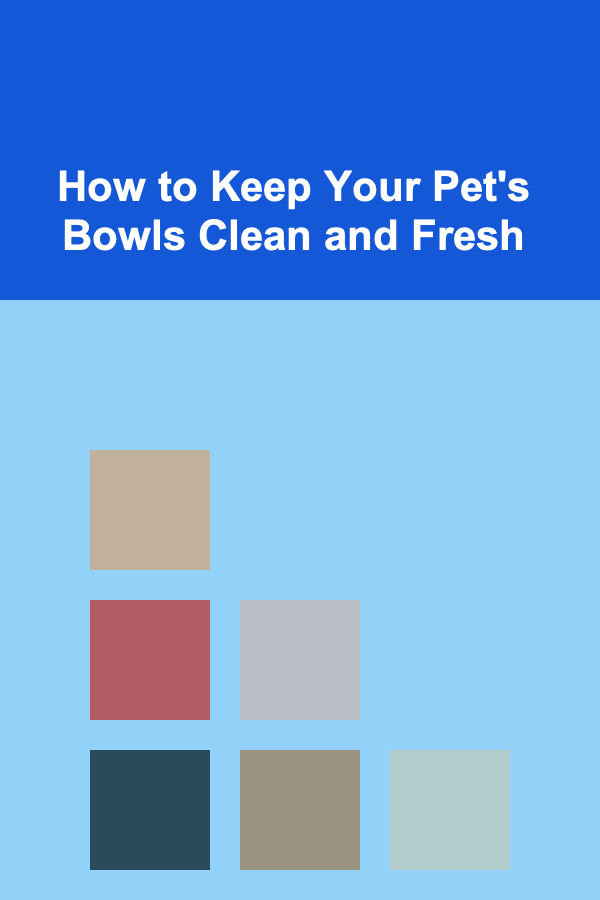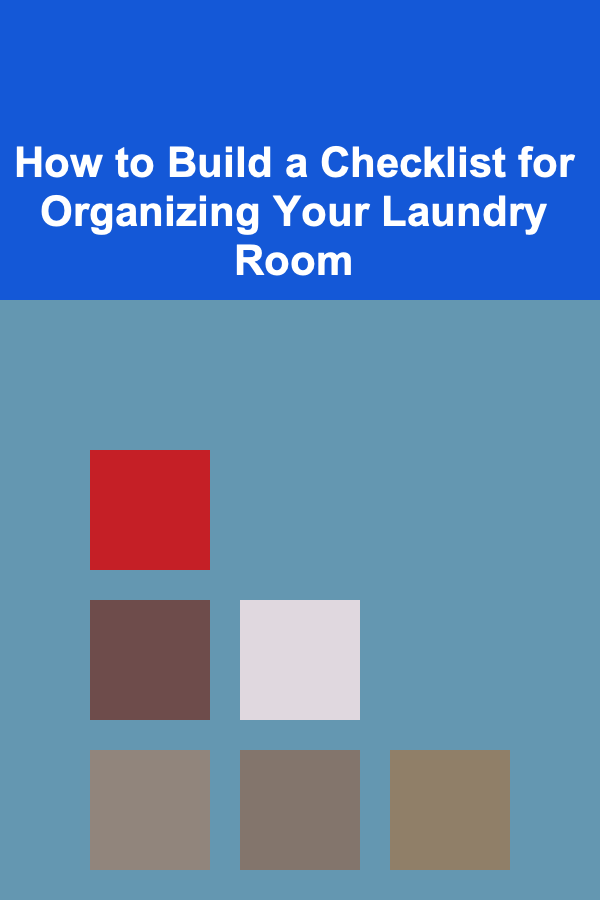
How to Keep Your Pet's Bowls Clean and Fresh
ebook include PDF & Audio bundle (Micro Guide)
$12.99$6.99
Limited Time Offer! Order within the next:

When you bring a pet into your home, you automatically commit to their health and well-being. A crucial aspect of caring for your pet is maintaining clean feeding bowls. Whether you have a dog, cat, or any other pet, their feeding bowls are more than just containers for food and water; they play a significant role in their overall health. Properly cleaning and maintaining your pet's bowls is essential not just for hygiene, but also to prevent the buildup of bacteria, mold, and other harmful pathogens that could affect your pet's health.
Keeping your pet's bowls clean and fresh is not just about aesthetics, but it's also a critical part of preventing health issues such as infections, digestive problems, or food poisoning. In this detailed guide, we will explore the various methods, materials, and habits you can adopt to ensure your pet's feeding bowls remain in tip-top shape.
Why Clean Pet Bowls Matter
Pets, especially dogs and cats, use their bowls multiple times a day. These bowls, in turn, accumulate food residues, bacteria, and germs. If left unchecked, this can lead to several issues such as:
1. Bacterial Growth
Pet bowls, particularly those that hold wet food or water, create an environment that fosters bacteria. For instance, water bowls can develop bacteria like E. coli or Salmonella, especially if they aren't cleaned regularly. If your pet is drinking from a contaminated bowl, they could ingest these harmful bacteria, leading to infections and digestive issues.
2. Mold and Mildew
If wet food is left in a pet's bowl for a long time, it can lead to the growth of mold and mildew, which can be harmful to your pet's health. Mold spores can irritate your pet's respiratory system and cause allergic reactions, particularly in pets with existing respiratory issues.
3. Odors
Old food, especially wet food, can start to smell after sitting for too long. Stale odors can make your pet's eating area unpleasant, which may discourage them from eating or drinking.
4. Contaminated Water
Water is an essential part of your pet's diet. If their water bowl isn't cleaned regularly, it can become contaminated with dirt, bacteria, and leftover food. This may lead to dehydration, especially if your pet refuses to drink from a bowl that has become dirty or unappealing.
5. Allergies and Health Problems
If pet bowls are left dirty, they can collect allergens such as dust, pollen, and pet dander. These allergens can then be transferred to your pet's food or water, potentially triggering allergic reactions, gastrointestinal upset, or even skin issues.
Materials of Pet Bowls and Their Maintenance
When it comes to keeping your pet's bowls clean and fresh, it's important to consider the material of the bowls themselves. Some materials are easier to clean and maintain than others. The three most common materials used for pet bowls are stainless steel, plastic, and ceramic. Each of these materials has its own set of benefits and challenges when it comes to cleaning.
Stainless Steel Bowls
Pros:
- Durable and long-lasting.
- Resistant to scratches, which makes them harder for bacteria to build up.
- Easy to clean and dishwasher-safe.
Cons:
- Can be slippery on smooth surfaces, which may cause the bowl to slide around while your pet eats or drinks.
- Can become dented or damaged if dropped.
Cleaning Tips:
- Daily Cleaning: After each meal, wash the bowl with hot water and soap. Stainless steel bowls are typically dishwasher-safe, which makes deep cleaning much easier. If washing by hand, use a soft sponge to avoid scratching the surface.
- Dealing with Stubborn Stains: For stubborn food stains or greasy residue, scrub the bowl with baking soda and hot water to remove any buildup.
- Drying: After washing, dry the bowl thoroughly with a clean towel to prevent watermarks from forming.
Plastic Bowls
Pros:
- Lightweight and inexpensive.
- Available in various sizes and colors.
Cons:
- Prone to scratching, which can trap bacteria.
- Can develop a "plastic" odor over time, especially if food or water is left in the bowl for too long.
- Some pets are sensitive to plastic and can develop skin irritation or a condition called "plastic chin," where the pet develops pimples or a rash around their chin.
Cleaning Tips:
- Daily Cleaning: Plastic bowls need to be washed thoroughly after each use to avoid bacterial buildup. Wash with warm water and mild dish soap. Avoid harsh chemical cleaners as these can leave residues that could harm your pet.
- Scratches: If the plastic bowl becomes scratched, it can harbor bacteria in the grooves. Consider replacing the bowl when this happens to ensure your pet's health and safety.
- Odor Removal: If the plastic bowl develops odors, scrub it with a mixture of baking soda and water, then rinse thoroughly.
Ceramic Bowls
Pros:
- Sturdy and often aesthetically pleasing.
- Resistant to scratches and stains.
Cons:
- Fragile and can break easily if dropped.
- Ceramic bowls can absorb food odors if not cleaned properly.
Cleaning Tips:
- Daily Cleaning: Wash ceramic bowls with warm water and soap after every meal. Be careful to inspect the bowl for any chips or cracks, as these can harbor bacteria.
- Stubborn Odors: For stubborn odors, soak the ceramic bowl in a mixture of white vinegar and water for a few hours before washing it. This helps eliminate food odors and leaves the bowl fresh.
- Avoid Dishwasher: While some ceramic bowls are dishwasher-safe, others may have painted or glazed surfaces that can wear off over time. Always check the manufacturer's care instructions.
Best Practices for Cleaning Pet Bowls
Maintaining clean and fresh pet bowls is an ongoing task that requires consistent effort. Here are some best practices to follow:
1. Establish a Cleaning Routine
Just like humans need to wash their dishes regularly, pet owners should set a daily routine for cleaning their pets' bowls. It is best to clean the bowls after every meal, especially if your pet eats wet food or leaves leftovers in their bowl. By doing this, you'll prevent food buildup, bacteria growth, and unpleasant odors from accumulating.
- Frequency: Clean food bowls and water bowls at least once a day. Water bowls should be checked and cleaned even more frequently if they appear dirty or if your pet is particularly messy.
- Deep Cleaning: Perform a deeper clean at least once a week using warm water, dish soap, and a brush. This will help ensure that no leftover food or bacteria are lingering on the surface of the bowls.
2. Use Non-Toxic, Pet-Safe Cleaning Products
When cleaning your pet's bowls, avoid using cleaning products that contain harsh chemicals or toxic substances, as these can leave residues that could harm your pet. Instead, opt for pet-safe cleaning products or natural cleaning alternatives, such as baking soda, vinegar, or mild dish soap.
- Baking Soda: Baking soda works wonders for removing odors and stains. Sprinkle some on the surface of the bowl, then scrub with a damp sponge or cloth.
- Vinegar: Vinegar is a natural disinfectant and deodorizer. Mix equal parts vinegar and water to clean the bowls and eliminate any lingering odors.
3. Dry Bowls Thoroughly
After washing your pet's bowls, make sure to dry them thoroughly. Pet bowls that retain moisture can attract bacteria and mold growth, so ensure that both the food and water bowls are completely dry before refilling them. A clean towel or dish rack can help you dry the bowls efficiently.
4. Keep the Eating Area Clean
In addition to cleaning the bowls themselves, the area where your pet eats and drinks should also be kept tidy. Food and water spills can lead to messes, attracting pests or bacteria. Consider using a pet mat or placemat to catch any spills and make cleaning easier.
- Cleaning Spills: If your pet tends to spill water or food, wipe up spills immediately to prevent them from soaking into the floor or becoming sticky.
5. Rotate Bowls
Having multiple sets of bowls for your pet can help maintain cleanliness and ensure that you always have a clean set on hand. Rotating between a few sets of bowls means that you can always have one set soaking or drying while using the others.
Conclusion
Keeping your pet's bowls clean and fresh is an essential part of maintaining their health and well-being. Regular cleaning, the right cleaning techniques, and using the right materials are all necessary to prevent bacterial growth, mold, and odors that can harm your pet. By following a daily routine, using pet-safe cleaning products, and taking proactive steps to ensure that your pet's bowls stay clean, you'll provide a safer and healthier environment for your pet to eat and drink from. Ultimately, a clean pet bowl leads to a happier, healthier pet.
Reading More From Our Other Websites
- [Organization Tip 101] How to Stage a Bathroom to Feel Spa-Like
- [Home Budget 101] How to Prioritize Home Renovations When on a Tight Budget
- [Organization Tip 101] How to Organize Your Craft Kits for Easy Access
- [Home Security 101] How to Enhance Your Home Security with a Smart Doorbell
- [Personal Care Tips 101] How to Manage Dry Skin During Winter Months
- [Paragliding Tip 101] Best Paragliding Simulators for Virtual Training in Variable Wind Conditions
- [Home Maintenance 101] How to Replace Common Appliance Parts Yourself
- [Home Storage Solution 101] How to Store Holiday Decorations Efficiently
- [Home Maintenance 101] How to Maintain Your HVAC System for Year-Round Comfort
- [Home Cleaning 101] How to Clean Your Home Naturally Using Only Eco-Friendly Products

How to Build a Checklist for Organizing Your Laundry Room
Read More
The Operations Coordinator's Guide: Streamlining Processes for Success
Read More
How To Understand Color Theory in Photography
Read More
How To Support Children's Healthy Attachments
Read More
How to Play Drums for Complete Novices
Read More
Choosing the Best Hand Trowel for Planting and Potting
Read MoreOther Products

How to Build a Checklist for Organizing Your Laundry Room
Read More
The Operations Coordinator's Guide: Streamlining Processes for Success
Read More
How To Understand Color Theory in Photography
Read More
How To Support Children's Healthy Attachments
Read More
How to Play Drums for Complete Novices
Read More